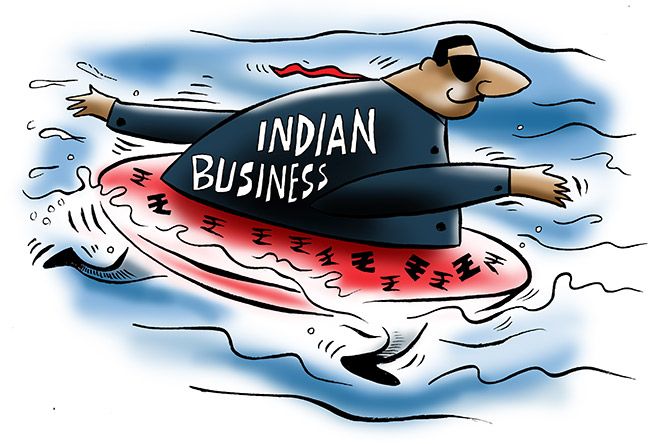 | « Back to article | Print this article |
The combined interest payment for India's top listed companies, excluding financial and oil and gas firms, was up 15.2 per cent year-on-year during the six months ended March 2019, outpacing the change in net sales and operating profit.
Illustration: Uttam Ghosh/Rediff.com

Borrowing costs have come back to bite corporate earnings after remaining muted for three years.
The combined interest payment for India's top listed companies, excluding financial and oil and gas firms, was up 15.2 per cent year-on-year (YoY) during the six months ended March 2019, outpacing the change in net sales and operating profit.
This was the fastest growth in companies’ interest payment in at least three-and-a-half years.
In comparison, companies’ combined operating profit or Ebitda (earnings before interest, tax, depreciation and amortisation) was down 5.9 per cent YoY during the second half of FY19, its worst show in at least three-and-a-half years.
In the same period, companies’ net sales were up 11 per cent YoY, showing moderation in growth on a sequential basis.
An uptick in interest payment without a matching improvement in operating profit puts pressure on net profits.
The combined net profit (adjusted for exceptional gains and losses) for the sample was down 3.5 per cent YoY during H2FY19, their worst show in at least three-and-a-half years.
Excluding exceptional gains, net profit was down 24 per cent during the period.
The analysis is based on the half-yearly numbers for 1,202 listed companies, excluding banks, non-bank lenders and oil and gas companies including Reliance Industries.
Analysts attribute this to a combination of incremental borrowing by companies and the firming up of interest rates in the last one year due to liquidity squeeze in the domestic market.
"There has been an increase in working capital requirement in many sectors as demand slowdown has resulted in inventory pile-up at companies and a rise in receivables (amount due from customers). This has forced companies to raise working capital loans to either fund incremental inventory or plug gaps in their cash flows," says G Chokkalingam, founder and MD, Equinomics Research & Advisory Services.
The numbers suggest that the rise in interest payment was due to both higher interest rates as well as an increase in borrowings.
The combined borrowings (based on unaudited numbers) was up 13.3 per cent YoY during H2FY19 against a decline of 3.3 per cent during the second half of 2017-18.
The total outstanding debt of the sample companies increased to Rs 12.7 trillion against Rs 11.2 trillion a year ago.
Companies borrowed at an interest rate of 9.04 per cent (on average) during H2FY19 against 8.85 per cent a year ago.
On the brighter side, the interest rate was down by around 24 basis points on a sequential basis from the highs of H1FY19.
One basis point is one-hundredth of a per cent.
Companies’ inventory was up 12.9 per cent YoY during H2FY19, outpacing the top line growth for the second consecutive half-yearly period.
In the same period, their receivables were up 12.8 per cent.
In comparison, companies’ total fixed assets (investment in plant and machinery) was up 9.7 per cent during H2FY19.
The rise in inventory and receivables was most prominent in sectors such as automobiles, power utilities, infrastructure, and construction sectors.
This, analysts say, corresponds with the changes in demand conditions in the respective industries.
“While auto makers have seen a rise in working capital due to sudden dip in demand in the last few months, power and infrastructure companies face delay in payments from government,” adds Chokkalingam.